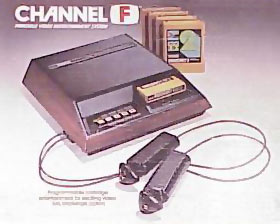Post by solidbatman on May 1, 2010 14:31:06 GMT -5
1972
Magnavox Odyssey

Interactive games have been around since 1958 when a tennis arcade game was released. Home systems did not enter the market until 1972 though when Ralph Baer and Magnavox released the Magnavox Odyssey. The Odyssey did not have interchangeable cartridges but came pre- programmed with games, as well as two controllers. There was no sound, it ran on batteries, and the system came with translucent overlays for the television to give color to the game. Dice, score sheets and poker chips were sometimes included to add to the game. Sales for the Odyssey floundered due to poor marketing by Magnavox and the false rumor that the system could only be played on a Magnavox television.
1975
Magnavox Odyssey 200

In 1975, Magnavox released the Odyssey 200. The 200 came with six paddles, three for each player. The system was little more than three variations of Pong.
Atari Pong

Also released in 1975 was the Atari/Sears Telegames Pong. The Home Pong, as it was called, was sold exclusively through Sears for just under $100. There were numerous Pong arcade games already out but this was the first home version. The system brought a suit from Magnavox for patent infringement. The Odyssey contained a ping pong game that closely resembled Pong. Atari had to settle outside of court to keep it's doors open.
1976
Coleco Telestar

Coleco released 14 versions of the Telestar. The first version sported three pong variations and was extremely similar to the Odyssey. These systems marked Coleco's entry into the market. Later on, Coleco would be a leading challenger of Atari in the videogame market.
Fairchild Channel F

Made by the people who started the Intel company, this system brought a new innovation to the home video game market. Human versus computer games. Before the Channel F, all games had to be played with another person. The Channel F also was the first programmable ROM cartridge based console. Twenty- six games were released for the Channel F on cartidges called videocarts. Two Pong variants were built into the Channel F.
Magnavox Odyssey

Interactive games have been around since 1958 when a tennis arcade game was released. Home systems did not enter the market until 1972 though when Ralph Baer and Magnavox released the Magnavox Odyssey. The Odyssey did not have interchangeable cartridges but came pre- programmed with games, as well as two controllers. There was no sound, it ran on batteries, and the system came with translucent overlays for the television to give color to the game. Dice, score sheets and poker chips were sometimes included to add to the game. Sales for the Odyssey floundered due to poor marketing by Magnavox and the false rumor that the system could only be played on a Magnavox television.
1975
Magnavox Odyssey 200

In 1975, Magnavox released the Odyssey 200. The 200 came with six paddles, three for each player. The system was little more than three variations of Pong.
Atari Pong
Also released in 1975 was the Atari/Sears Telegames Pong. The Home Pong, as it was called, was sold exclusively through Sears for just under $100. There were numerous Pong arcade games already out but this was the first home version. The system brought a suit from Magnavox for patent infringement. The Odyssey contained a ping pong game that closely resembled Pong. Atari had to settle outside of court to keep it's doors open.
1976
Coleco Telestar

Coleco released 14 versions of the Telestar. The first version sported three pong variations and was extremely similar to the Odyssey. These systems marked Coleco's entry into the market. Later on, Coleco would be a leading challenger of Atari in the videogame market.
Fairchild Channel F

Made by the people who started the Intel company, this system brought a new innovation to the home video game market. Human versus computer games. Before the Channel F, all games had to be played with another person. The Channel F also was the first programmable ROM cartridge based console. Twenty- six games were released for the Channel F on cartidges called videocarts. Two Pong variants were built into the Channel F.

